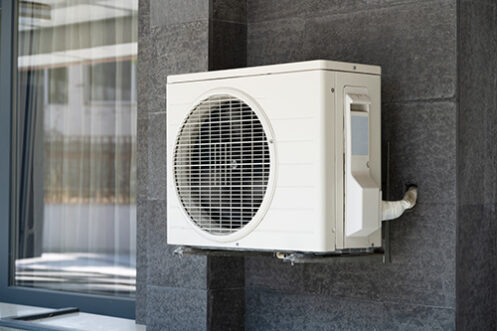How To Choose Between Central AC and a Mini-Split

With average summer temperatures in Puyallup, WA, climbing each year, air conditioning is more of a necessity here than ever before. Right now, the two principal options to installing an AC system to your home are a central air conditioning system or a mini-split. To help you decide between the two, here are the pros and cons of both so you understand what you’re getting into with each.
The Pros of Central AC Systems
The most common type of whole-house AC system you’ll find in use is a central AC system. The main advantage of such systems is that they offer efficient cooling and relatively low operating costs. On top of that, central air conditioners also have an aesthetic advantage since the only sign of having one is a handful of small vents in each room of your home and a single outdoor unit that serves your whole home.
Another advantage of central air conditioning systems is their longevity. You can expect the average central air conditioner to give you between 15 and 20 years of reliable service if you maintain them well. That makes the cost of a central air conditioning system easier to accept when you divide it over their useful lifetimes.
Finally, central air conditioners also have an advantage over other options because they’re quiet. Inside a home with central air conditioning, it’s difficult to hear any sign of its operation in most cases. And while a central air conditioner’s outdoor unit can be a bit loud, it’s not loud enough to pose a problem for residents in most homes.
The Cons of Central AC Systems
Central air conditioning systems do come with some disadvantages, however. The biggest one is that they require extensive ductwork inside a home’s walls to operate. So, if your home wasn’t built with ductwork for a central AC, this means you have to add it, which can be prohibitively costly. To do so would also require tearing apart many of your home’s finished walls, which isn’t something many homeowners would be willing to do.
Another disadvantage of central AC systems is that they’re a bit inflexible. They usually force you to cool off your entire home, even if you’re only using one or two rooms at any given time. That’s because most central AC systems don’t feature zoning capabilities, and it costs extra to install a zoned system. Plus, since they usually rely on a single, centrally-located thermostat, central AC can end up producing hot and cold spots throughout your home. To combat that, it’s necessary to leave all of your home’s vents open and unblocked. Plus, it’s a good idea to leave interior doors open so the temperatures equalize, which is rather inconvenient for homes with multiple occupants.
The Pros of Mini-Split AC Systems
A mini-split AC system offers a unique alternative to central AC that comes with some major advantages. The biggest advantage is that they rely on individual air handlers in each room you wish to keep cool. That means you can set a different temperature in every room if you want, and close as many doors as you want without affecting your comfort.
The use of individual air handlers also means you don’t need ductwork to support a mini-split. That makes them an excellent option for older homes that don’t have preexisting ductwork. Installation of a mini-split only requires a small hole through each wall where you have an air handler installed. The hole allows for the passage of the power and refrigerant lines that connect each air handler to the system’s outdoor unit.
Plus, mini-split AC systems offer even quieter operation than central ACs, both inside and outside your home. Their outdoor units are typically far smaller and quieter than those of comparable central AC systems. And their indoor units tend to rely on variable-speed fans, which means they’re only audible when you need maximum cooling power.
The Cons of Mini-Split AC Systems
Mini-split AC systems do have disadvantages, too. For one thing, they’re a bit more expensive upfront than central AC systems of similar size. And they’re harder to maintain since you have to keep air filters in each air handler clean at all times. Plus, the multiple air handlers make mini-splits more mechanically complex, which means long-term repair costs may be higher than those associated with central AC.
Then there’s also the fact that installing a mini-split may cost more than a central air conditioner. Since there are more components to deal with, there’s more labor involved. And having an air handler in each room means a mini-split is far more visible than a central air conditioner. So, homeowners that worry about aesthetics may not want a mini-split’s air handlers clashing with their décor.
Your Go-to HVAC Company
Whichever type of AC system you choose for your Puyallup home, Puyallup Heating & Air Conditioning can help. We’ve served the local community since 1946, amassing a list of satisfied customers over 100,000 strong. We offer complete HVAC installation, repair, and maintenance services, including both central and mini-split AC systems. And we even offer financing on approved credit to help you afford the system your home needs.
So, for central ACs, mini-split ACs, and more in Puyallup, call Puyallup Heating & Air Conditioning today!
Tags: AC Installation, Ductless Mini-Split Installation


